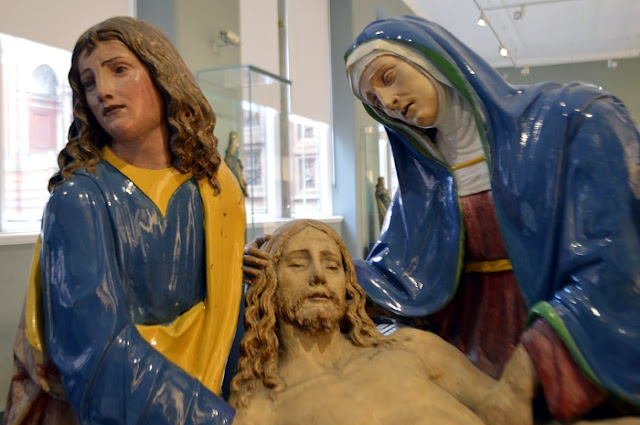The Lamentation over the Dead Christ
I’ve spoken before of
my love of the work of Andrea della Robbia and his mindbendingly garish colour
choices. This terracotta group, entitled The Lamentation over the Dead Christ,
dates to about 1510-1515 and comes from his workshop, if not from the hand of
the master himself. As the work incorporates the Virgin Mary cradling the
figure of the dead Christ, it may be classed as a Pietà. In this arrangement,
Mary is at the centre, with St John the Evangelist to the left and Mary Magdalene on the
right.
Such a piece would have
been intended as a focus for religious devotion in a church, and terracotta was
a particularly popular medium at this period in Tuscany and the area around
Bologna. The V&A’s information card notes that groups like this were
particularly difficult to make and it seems that Mary Magdalene shattered
during the first (biscuit) firing. This meant that the figure was unsuitable
for further firing to add the glaze and instead she was painted. The other
figures are all partially glazed and, while I do mock the palette, I’m still
taken aback at how vibrant and vivid the colours are some 500 years after it
was first made.
There’s so much to like
about this piece, from the obvious skill in its manufacture, to the ‘make do
& mend’ approach to the misfired Magdalene. There’s even something
incredibly charming (if wholly blasphemous) in Christ’s exceptionally chilled
position and facial expression, like a terracotta Snoop Dogg. For me, the
greatest charm of the piece is the contrast between the front and the back. The
front is exquisite and must have provided a point of concentration for
generations of worshipers. But the back is so strange, almost alien in
appearance. As the piece was never intended to be seen in the round, there was
no need to waste unnecessary effort and clay on detail – just enough to keep it
structurally stable remains. Whichever way you look at this sculpture, it
remains a visually arresting and thought provoking piece.






Comments
Post a Comment